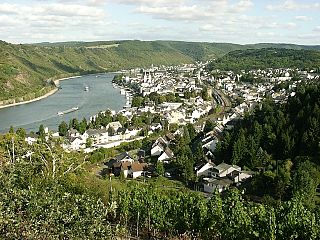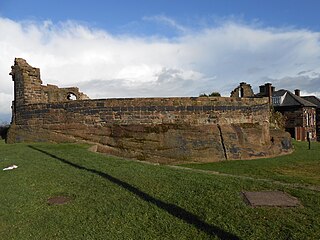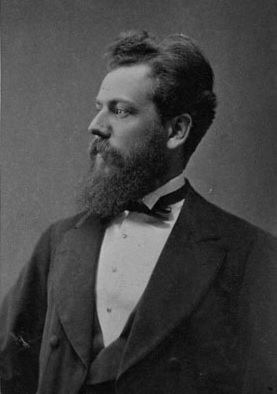
Bohuslän is a Swedish province in Götaland, on the northernmost part of the country's west coast. It is bordered by Dalsland to the northeast, Västergötland to the southeast, the Skagerrak arm of the North Sea to the west, and the county of Østfold, in Norway, to the north. In English it literally means Bohus County, although it shared counties with the city of Gothenburg prior to the 1998 county merger and thus was not an administrative unit in its own right.

Bodiam Castle is a 14th-century moated castle near Robertsbridge in East Sussex, England. It was built in 1385 by Sir Edward Dalyngrigge, a former knight of Edward III, with the permission of Richard II, ostensibly to defend the area against French invasion during the Hundred Years' War. Of quadrangular plan, Bodiam Castle has no keep, having its various chambers built around the outer defensive walls and inner courts. Its corners and entrance are marked by towers, and topped by crenellations. Its structure, details and situation in an artificial watery landscape indicate that display was an important aspect of the castle's design as well as defence. It was the home of the Dalyngrigge family and the centre of the manor of Bodiam.

Doune Castle is a medieval stronghold near the village of Doune, in the Stirling council area of central Scotland and the historic county of Perthshire. The castle is sited on a wooded bend where the Ardoch Burn flows into the River Teith. It lies 8 miles northwest of Stirling, where the Teith flows into the River Forth. Upstream, 8 miles further northwest, the town of Callander lies at the edge of the Trossachs, on the fringe of the Scottish Highlands.

Uddevalla is a town and the seat of Uddevalla Municipality in Västra Götaland County, Sweden. In 2015, it had a population of 34,781.

Tudor Revival architecture, also known as mock Tudor in the UK, first manifested in domestic architecture in the United Kingdom in the latter half of the 19th century. Based on revival of aspects that were perceived as Tudor architecture, in reality it usually took the style of English vernacular architecture of the Middle Ages that had survived into the Tudor period.

Boppard, formerly also spelled Boppart, is a town and municipality in the Rhein-Hunsrück-Kreis (district) in Rhineland-Palatinate, Germany, lying in the Rhine Gorge, a UNESCO World Heritage Site. The town is also a state-recognized tourism resort (Fremdenverkehrsort) and is a winegrowing centre.

Faversham Stone Chapel also known as Our Lady of Elwarton, is a medieval chapel built on top of a Romano-British mausoleum. The chapel is located in what is thought to have been the Roman settlement of Durolevum, near the modern town of Faversham, in Kent, England. It is the only chapel in England known to incorporate the remains of an ancient shrine or mausoleum.

Halton Castle is a castle in the village of Halton, part of the town of Runcorn, Cheshire, England. The castle is on the top of Halton Hill, a sandstone prominence overlooking the village. The original building, a motte-and-bailey castle began in 1071, was replaced with the current sandstone castle in the 13th century. Building alterations continued until at least 1609, when the structure is recorded as in disrepair. The castle is recorded in the National Heritage List for England as a designated Grade I listed building, and a scheduled monument.

Burg Kreuzenstein is a castle near Leobendorf in Lower Austria, Austria. Burg Kreuzenstein is 265 metres (869 ft) above sea level. It was constructed on the remains of a medieval castle that had fallen into disrepair and was then demolished during the Thirty Years' War. Intended to be a family vault for the Wilczek family, it was rebuilt in the 19th century by Count Nepomuk Wilczek with money from the family's large Silesian coal mines. Kreuzenstein is interesting in that it was constructed out of sections of medieval structures purchased by the family from all over Europe to form an authentic-looking castle. Thus, the castle can be considered both a 'neo-' and 'original' medieval structure. The castle is sometimes used as a location for films, for example in Baron Blood, directed by Mario Bava in 1972.

Sturehov Manor is a manor house in Botkyrka Municipality, a suburb of Stockholm, Sweden. The manor contains well-preserved 18th-century interiors.

Whorlton Castle is a ruined medieval castle situated near the abandoned village of Whorlton in North Yorkshire, England. It was established in the early 12th century as a Norman motte-and-bailey associated with the nearby settlement. The castle is an unusual example of a motte-and-bailey that remained in use throughout the Middle Ages and into the early modern period.

Bohusläningen is a daily newspaper, focusing on central and northern Bohuslän, as well as western Dalsland.

Ture Robert Ferdinand Malmgren was a Swedish journalist, book publisher, and municipal politician. A prominent figure in his hometown of Uddevalla, Malmgren became a colorful and well-known part of the city's history through, among other things, his long-lasting ownership of the newspaper Bohusläningen, work in the local political scene, eccentric and extravagant lifestyle, and faux-medieval Tureborg Castle.

Fjällhyddan, also known as Jakthyddan and other variants of that name, was a building constructed in Uddevalla, Sweden, during the late 19th century. It was created by Ture Malmgren (1851–1922), a prominent – and highly eccentric – local businessman and politician. Today the building is a ruin.
Ture Valleys or Ture's Valleys is a nature reserve in the town of Uddevalla, Sweden. Located by the foot of the mountain Fjällsätern, on which Tureborg Castle stands, close to the Tureborg district, the area is named for Ture Malmgren (1851–1922), a prominent, wealthy and highly eccentric local politician and newspaper owner, once chairman of the Uddevalla city council and founder of Bohusläningen. Originally proposed in 1979, a plan to survey the area was put in place in 1988, and the nature reserve was finally created in 1991. The nature reserve – administrated by Uddevalla Municipality, and about seven hectares large – is a popular hiking area.

The Eastern Cemetery is a cemetery in Uddevalla, Sweden. It belongs to the Church of Sweden, which professes to Lutheranism, and serves as burial grounds for – primarily – the members of Bäve Parish.
The Uddevalla Suffrage Association was a late-19th-century political movement founded in Uddevalla, Sweden. Local historians and the Swedish Social Democratic Party consider it the first political predecessor of the Swedish labour movement in the province of Bohuslän. Its purpose was to bring about universal suffrage in Sweden: At the time, suffrage in the country was restricted to men and based on personal wealth, therefore excluding most of the urban and rural working class from the electoral process. The Uddevalla Suffrage Association was one of many groups throughout Sweden that helped bring democratic thought into the common discourse and make way for the political breakthrough of the labour movement.

The tomb of Ture Malmgren is a structure located in Uddevalla, Bohuslän, Sweden. It is located by the foot of Fjällsätern, near the center of the residential district of Tureborg. Carved into the sheer cliff face, it was intended as the final resting place of the local politician and publicist Ture Malmgren. Despite his own wishes, Malmgren was instead interred elsewhere after his death in 1922, effectively rendering the empty rock-cut tomb a cenotaph of sorts.

Fjällsätern is a minor mountain in southern Uddevalla, Sweden. Its summit reaches 105.9 metres (347 ft) above sea level according to one 1950 estimate, making it the area's second highest. There the local politician and publicist Ture Malmgren (1851–1922) began building his grand Tureborg Castle, today a ruin, in 1899. Along its slopes Malmgren constructed several other structures, among them the likewise faux-medieval summer residence Fjällhyddan, and his own would-be tomb. The area was once completely barren, but Malmgren – who was engaged in the tree-planting movement of that time – promised his wife Hilma that she would one day be able to walk beneath trees on Fjällsätern, and set about planting the thick forest of today. A nature reserve named after him, Ture Valleys, is situated on the mountain's eastern side.

Tureholm is a small and uninhabited artificial river island in Bäveån, which runs through the city of Uddevalla in Bohuslän, Sweden. It was created in the late 19th century or early 20th century by the local politician and publicist Ture Malmgren (1851–1922), close to his residence Villa Elfkullen. According to his newspaper Bohusläningen, the process of land reclamation took place because Malmgren enjoyed water, and wanted to be closer to the river. According to another author, it partially functioned as a wave breaker, preventing the ice of the late winters from pulling the nearby bridge with it. A small bridge is said to have formerly led from the mainland to its now overgrown embankments. The islet was named in reference to Malmgren by his friends. Other places named for him include the ruined Tureborg Castle and the nature reserve Ture Valleys.
























